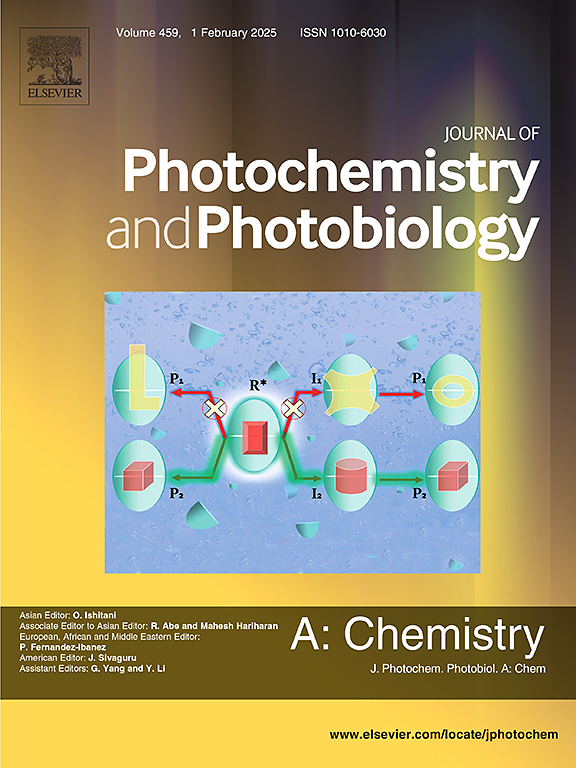以铑@氮化石墨碳纳米片为有效催化剂的可见光光催化选择性氧化醇类反应
IF 4.1
3区 化学
Q2 CHEMISTRY, PHYSICAL
Journal of Photochemistry and Photobiology A-chemistry
Pub Date : 2025-02-24
DOI:10.1016/j.jphotochem.2025.116360
引用次数: 0
摘要
本文章由计算机程序翻译,如有差异,请以英文原文为准。

Visible light photocatalytic selective oxidation of alcohols by rhodium@graphitic carbon nitride nanosheets as effective catalyst
In this work, we present the development of a novel photocatalyst system based on graphitic carbon nitride (g-C3N4) nanosheets decorated with Rhodium, denoted as Rh/g-C3N4, in Selective Oxidation of alcohols. The graphitic carbon nitride nanosheets were synthesized from OAT (Oxi Amino Triazine) as a waste material which is a by-product of the melamine unit of North Khorasan Petrochemical Company. The rhodium precursors employed were 5-methyl-5-(2-pyridyl)-2,4-imidazolidenedione and K3[RhCl6], which formed Rh metallic nanoparticles on the surface of the g-C3N4 support. The Rh particles anchored on g-C3N4 are instrumental in enhancing the efficient separation of photogenerated charges and exhibit considerable absorption under the visible-light. More notably, Rh/g-C3N4 demonstrates performance that exceeds that of both bare g-C3N4 and thecomplex. This new class of heterogeneous photocatalysts demonstrates exceptional activity and selectivity in the oxidation of alcohols under visible light irradiation. A conversion rate of 88 % was achieved using the Rh/g-C3N4 photocatalyst after 120 min of visible light irradiation. These features make the developed g-C3N4-supported Rh particles a promising candidate for practical applications in organic synthesis. The produced catalyst was characterized using a variety of techniques.
求助全文
通过发布文献求助,成功后即可免费获取论文全文。
去求助
来源期刊
CiteScore
7.90
自引率
7.00%
发文量
580
审稿时长
48 days
期刊介绍:
JPPA publishes the results of fundamental studies on all aspects of chemical phenomena induced by interactions between light and molecules/matter of all kinds.
All systems capable of being described at the molecular or integrated multimolecular level are appropriate for the journal. This includes all molecular chemical species as well as biomolecular, supramolecular, polymer and other macromolecular systems, as well as solid state photochemistry. In addition, the journal publishes studies of semiconductor and other photoactive organic and inorganic materials, photocatalysis (organic, inorganic, supramolecular and superconductor).
The scope includes condensed and gas phase photochemistry, as well as synchrotron radiation chemistry. A broad range of processes and techniques in photochemistry are covered such as light induced energy, electron and proton transfer; nonlinear photochemical behavior; mechanistic investigation of photochemical reactions and identification of the products of photochemical reactions; quantum yield determinations and measurements of rate constants for primary and secondary photochemical processes; steady-state and time-resolved emission, ultrafast spectroscopic methods, single molecule spectroscopy, time resolved X-ray diffraction, luminescence microscopy, and scattering spectroscopy applied to photochemistry. Papers in emerging and applied areas such as luminescent sensors, electroluminescence, solar energy conversion, atmospheric photochemistry, environmental remediation, and related photocatalytic chemistry are also welcome.

 求助内容:
求助内容: 应助结果提醒方式:
应助结果提醒方式:


